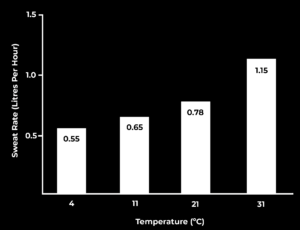Fluid requirements during exercise in the winter months
We are all aware of our fluid losses during exercise on hot summer days. We often experience sweat dripping from our skin surface, feeling hot, or are even aware of sweat evaporating (leaving salty skin or salty patches on our clothing). This evaporation is what effectively contributes to removing heat from our body allowing us to continue exercising without our body core temperature rising too high. However, we may be less aware of our fluid losses during exercise when it comes to exercising in the winter months. Part of the reason for this reduced awareness is that in cooler environments we are better able to regulate our body temperature (due to less heat stress). So, we sweat less at lower air temperatures. When we sweat less we are not as aware of our losses, although we are still losing fluid through evaporative sweat losses as well as losses of water vapour through our breathing.
Sweat losses
The image below shows sweat rate data when wearing shorts and T-shirt during moderate intensity exercise conducted in different environmental temperatures. It highlights the typical sweat rate response in a group of male recreationally active individuals. We can see that as ambient temperature rises there is also a rise in the sweat rate per hour (no surprises there), but it should be noted that even at cold (4°C) and cool (11°C) ambient temperatures sweat rate can be in the region of 0.5 to 0.6 Litres per hour. These values in the cold (4°C) and cool (11°C) conditions will be higher if more clothing is worn, so with your winter clothing on you could easily reach the sweat rates reported for 21°C or more. It should also be pointed out that these are average data from a group of males. Individuals can have quite different sweat rate responses so it is best to find out your own sweat rate at different temperatures.

Water losses through breathing
Respiratory water losses amount to about 2 to 5 g of water per minute when exercising at a moderate intensity in a dry air environment (equating to 120-300ml per hour). Often in cold damp weather there is greater moisture in the air meaning that respiratory water losses will be lower than this range. However, on clear crisp cold weather days where the air is very dry, respiratory water losses may be nearer the upper end of this range. This water loss of breathing on cold dry days therefore represents a big proportion of total fluid losses when you are sweating less. That is, water loss from breathing could add 50% to your water losses per hour (600ml/h sweat loss plus 300ml respiratory water loss). Therefore, over several hours of outdoor exercise in a cold dry environment respiratory water loss, on top of your sweat loss, means that your total fluid requirements may be greater than you think!
What about sex differences?
Now, you would be right to point out that the observations above were gathered on males and there might be a difference when considering female fluid replacement requirements. Indeed, the majority of research conducted into sweating rates and respiratory water losses has been done on men. However, studies examining women typically report lower whole body sweat rates on average, with women also able to control body core temperature rises equally as well as men. Therefore, this is typically interpreted as women being more efficient at sweating than men. This translates into overall less fluid requirement for exercising women, but again fluid losses / sweat rates should be assessed on an individual basis.
How do I estimate my sweat rate during winter training?
The easiest thing to do to estimate your sweat rate is to weigh yourself in your underwear (or ideally with no clothes on) before and after your exercise sessions. If you also measure how much fluid you have ingested between each weighing time point then you can correct your mass loss to estimate sweat rate and respiratory water losses. For example, if you weighed 68.3kg before going out on your winter bike for 2 hours, you consumed 700ml of fluid from your drinks bottle over that time period, and weighed in at 67.6kg after exercise, then your total water loss (sweat loss plus respiratory water loss) per hour would be: 0.7 Litres per hour
The calculation is: 68.3kg weight before, + 0.7 kg ingested = 69kg. Then subtract weight after exercise (67.6kg) which leaves 1.4kg lost over 2 hours of exercise. Thus, estimated fluid loss is 0.7 L per hour.
You should note that if any urine is passed during the period of time between weighing yourself, this will alter the calculation. In laboratory studies we collect all urine so that the volume can be factored into the estimation of total fluid losses.
References:
Galloway and Maughan (1997) Effects of ambient temperature on the capacity to perform prolonged cycle exercise in man. Med Sci Sports Exerc. 29(9):1240-1249.
Mitchell, Nadel and Stolwijk (1972) Respiratory weight losses during exercise. J Appl Physiol. 32:474-476.
Wickham, McCarthy, Spriet and Cheung (2021) Sex differences in the physiological responses to exercise-induced dehydration: consequences and mechanisms. J Appl Physiol. 131: 504–510
Rodriguez-Giustiniani, Rodriguez-Sanchez and Galloway (2021) Fluid and electrolyte balance considerations for female athletes. Eur J Sort Sci. Jun 17;1-12. doi: 10.1080/17461391.2021.1939428.
